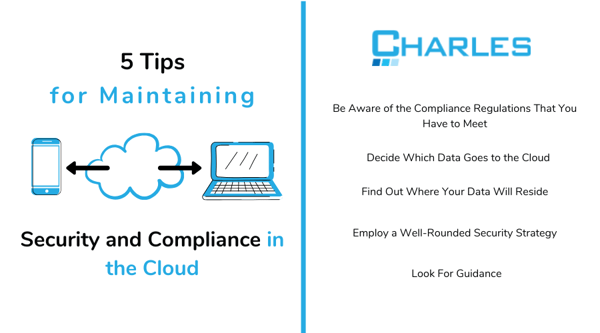
More and more companies are leveraging cloud computing to cut down costs, avail new services, and benefit from the flexibility and scalability it offers. But if your small- to medium-sized business (SMB) is looking to follow suit, you have to be ready for a new set of challenges to maintain security and compliance in the cloud.
Here are five tips that will help you overcome these challenges.
#1 Be Aware of the Compliance Regulations That You Have to Meet
Depending on your industry and the type of transactions you handle, your company may be subject to comply with a variety of standards and regulations, such as the Health Insurance Portability and Accountability Act (HIPAA) and Gramm-Leach-Bliley Act (GLBA).

Failure to meet your compliance requirements can result in hefty fines, lawsuits, cybersecurity incidents, and reputation damage, so make sure you know the details of all of the regulations and standards that apply to your company.
#2 Decide Which Data Goes to the Cloud
Classify all of your company data and identify which ones will be moved to the cloud. For security and compliance reasons, it’s better to keep highly confidential or sensitive information in your internal network. A possible workaround is to use a private cloud solution. This will offer you a greater level of security, enabling you to adhere to compliance requirements.
Related article: Public Cloud vs. Private Cloud
#3 Find Out Where Your Data Will Reside
When you’re evaluating potential cloud services providers (CSP), you have to ask for documentation on the location of their servers. Even if the compliance regulations you’re subject to don’t require US-based servers, you still have to know in which countries your data will be processed and stored. Other countries have different data protection, localization, and sovereignty laws that may impact your privacy or require you to practice certain measures.
#4 Employ a Well-Rounded Security Strategy
Laws often lag behind the tech it wishes to regulate. This means that being compliant with data regulations for the sake of compliance does not necessarily mean you are protected from cyberthreats. What you want to do instead is implement industry-standard cybersecurity measures that continually factor in compliance with evolving laws in their protocols.
To achieve this, you should cover the following areas:
- Governance and Policy
Maintaining security and compliance in the cloud is a shared responsibility between the user (you) and the CSP. (Note: Roles and responsibilities will differ depending on the cloud service model you avail.) So before partnering with a CSP, carefully review the service level agreements in their proposal to understand up to what degree they will protect your information. This will also help you determine how they would meet the cloud compliance requirements that you must comply with. Ask them to validate the compliance standards and security programs they support with audits and certifications.On your side, ensure your company’s cybersecurity governance and policies are written and well-communicated internally.
- Asset Management
While the CSP is responsible for managing its infrastructure assets, you are responsible for managing your company’s assets, such as operating systems and applications.To successfully manage your assets, record all the assets you’ve deployed, their corresponding owner, and security level. Make sure all of these are correctly configured to meet security best practices. Monitor user activity for unusual behavior, unauthorized access to sensitive files, and adherence to company security policies.
- Access Control
You should understand which persons at your company, your CSP, and third-party contractors have access to what. Only give users access to the data and systems they need to do their job. Conduct a regular review and audit of your access controls to ensure proper implementation.When evaluating prospective CSPs, check if they have sound access controls in place. Ask if they can provide documentation that shows which users have access to a system and when and to what degree. This documentation is crucial for compliance with many regulations such as the GLBA.
-
Incident Response
Establish the roles and responsibilities of your company and the CSP, should a security incident arise. Ensure that there are clear, documented response processes (e.g., receiving alerts and how quickly) and strategies in place for various types of incidents. -
Business Continuity
Check your potential CSP’s resilience and disaster recovery strategy. What are their guarantees and limitations with regard to uptime? Should a natural disaster or unplanned outage strike, will your cloud-based data and services remain accessible? Make sure your CSP can meet the disaster recovery requirements you need to comply with. -
Risk Assessment and Audit
Conduct regular risk assessments and audits to stay proactive in understanding gaps in your security and how you address them to improve your security posture.
#5 Look For Guidance
Maintaining security and compliance in the cloud is a complex and continuous process. That’s why you should partner with a managed IT services provider (MSP) like Charles IT. We can help you navigate compliance considerations and ensure that proper cloud security controls are enforced consistently. Reach out to our team today to get the guidance your company needs or download our FREE eBook to learn more about managed cloud services.




